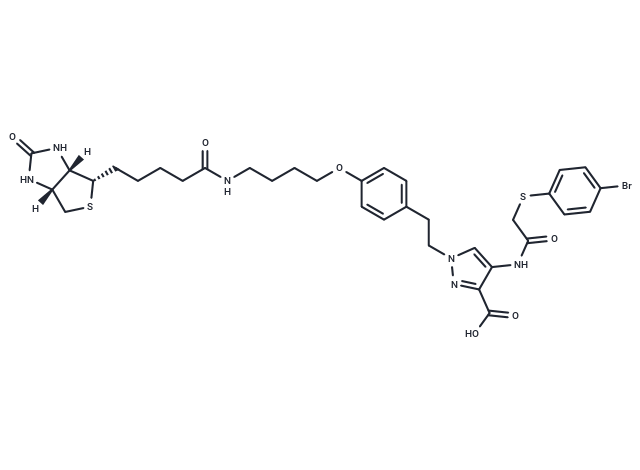- Remove All
 Your shopping cart is currently empty
Your shopping cart is currently empty
Shopping Cart
Biotin-tagged KR-33493
Catalog No. T85858Cas No. 1872262-53-7
Biotin-tagged KR-33493 is a multifunctional dye widely utilized in various sectors. In biological experiments, dyes facilitate the observation and analysis of cell structures, tracking of biomolecules, evaluation of cell functions, differentiation of cell types, detection of biomolecules, examination of tissue pathology, and monitoring of microorganisms. These applications extend from fundamental research to a broad spectrum of clinical diagnostics. Additionally, dyes find extensive use in traditional industries like textile dyeing and emerging domains such as functional textile processing, food pigments, and dye-sensitized solar cells.

Biotin-tagged KR-33493
Catalog No. T85858Cas No. 1872262-53-7
Biotin-tagged KR-33493 is a multifunctional dye widely utilized in various sectors. In biological experiments, dyes facilitate the observation and analysis of cell structures, tracking of biomolecules, evaluation of cell functions, differentiation of cell types, detection of biomolecules, examination of tissue pathology, and monitoring of microorganisms. These applications extend from fundamental research to a broad spectrum of clinical diagnostics. Additionally, dyes find extensive use in traditional industries like textile dyeing and emerging domains such as functional textile processing, food pigments, and dye-sensitized solar cells.
| Pack Size | Price | Availability | Quantity |
|---|---|---|---|
| 10 mg | Inquiry | Inquiry | |
| 50 mg | Inquiry | Inquiry |
Bulk & Custom
Add to Cart
Questions
View MoreContact us for more batch information
Resource Download
Product Introduction
Bioactivity
Chemical Properties
| Description | Biotin-tagged KR-33493 is a multifunctional dye widely utilized in various sectors. In biological experiments, dyes facilitate the observation and analysis of cell structures, tracking of biomolecules, evaluation of cell functions, differentiation of cell types, detection of biomolecules, examination of tissue pathology, and monitoring of microorganisms. These applications extend from fundamental research to a broad spectrum of clinical diagnostics. Additionally, dyes find extensive use in traditional industries like textile dyeing and emerging domains such as functional textile processing, food pigments, and dye-sensitized solar cells. |
| Molecular Weight | 773.76 |
| Formula | C34H41BrN6O6S2 |
| Cas No. | 1872262-53-7 |
Storage & Solubility Information
| Storage | Powder: -20°C for 3 years | In solvent: -80°C for 1 year | Shipping with blue ice. |
Calculator
In Vivo Formulation Calculator (Clear solution)
Please enter your animal experiment information in the following box and click Calculate to obtain the mother liquor preparation method and in vivo formula preparation method:
Mother liquor preparation method: 2 mg of drug dissolved in 50 μL DMSO (mother liquor concentration of 40 mg/mL), if you need to configure a concentration that exceeds the solubility of the product, please contact us first.
(mother liquor concentration of 40 mg/mL), if you need to configure a concentration that exceeds the solubility of the product, please contact us first.
Preparation method for in vivo formula: Take 50 μL DMSO main solution, add 300 μLPEG300
main solution, add 300 μLPEG300 mix well and clarify, then add 50 more μL Tween 80, mix well and clarify, then add 600 more μLddH2O
mix well and clarify, then add 50 more μL Tween 80, mix well and clarify, then add 600 more μLddH2O mix well and clarify
mix well and clarify
For Reference Only. Please develop an appropriate dissolution method based on your laboratory animals and route of administration.
Dose Conversion
You can also refer to dose conversion for different animals. More Dose Conversion
Tech Support
Please see Inhibitor Handling Instructions for more frequently ask questions. Topics include: how to prepare stock solutions, how to store products, and cautions on cell-based assays & animal experiments, etc
Related Tags: buy Biotin-tagged KR-33493 | purchase Biotin-tagged KR-33493 | Biotin-tagged KR-33493 cost | order Biotin-tagged KR-33493 | Biotin-tagged KR-33493 chemical structure | Biotin-tagged KR-33493 formula | Biotin-tagged KR-33493 molecular weight

Copyright © 2015-2025 TargetMol Chemicals Inc. All Rights Reserved.




